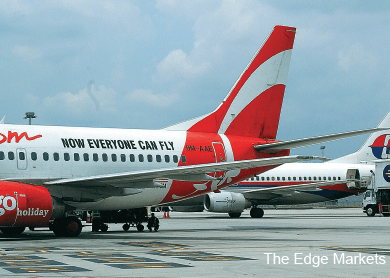
KUALA LUMPUR (June 26): Maybank Investment Bank Bhd (Maybank IB) said AirAsia Bhd would be the biggest beneficiary of Malaysia Airline System Bhd’s (MAS) second round of route cuts that will take effect from August this year, due to the overlap of routes between the two airlines.

“The first wave of route cuts (Kuala Lumpur to Frankfurt, Krabi, Kochi and Kunming) was immaterial and has no noticeable impact on AirAsia and Malindo Air.
“However, the impact of the upcoming second wave should be more pronounced with frequency reductions on several regional routes and termination of two routes (Kuala Lumpur to Brisbane and Male),” said Maybank IB analyst Mohshin Aziz in a research note today.
He said MAS is believed to have launched the second wave of route and capacity cuts based on Maybank IB’s channel checks and these cuts are more directed towards the regional and Australian routes, which intersects with AirAsia, AirAsia X and Malindo Air’s portfolios directly.
“Thus, we believe there will be a shift in market equilibrium and load factor and yields are likely to rise for the three carriers. The quantum of impact will vary according to how big and how well served the route is,” he said.
Yesterday, some Australian news sites reported that MAS will drop flights to Brisbane and reduce frequencies to other Australian ports from August onwards.
It was reported that the Kuala Lumpur-Perth flight will be cut to a daily service from 12 times a week currently, while Melbourne and Sydney will be reduced from three times a day to twice daily; Adelaide will be trimmed to four times a week.
Meanwhile, Mohshin continued to say that MAS is expected to announce even more route cuts and capacity reduction, following the rationalisation of its staff, which involves the termination of 6,000 employees by end-August 2015.
Mohshin said further route cuts will benefit the aviation industry as a whole, reduce excess capacity and wastages, boost load factor, and reverse the declining yield trend.
“The biggest beneficiary is AirAsia (fundamental: 0.2; valuation: 1.4) as it has the most route overlap with MAS, followed by Malindo Air, AirAsia X Bhd and to a lesser extend Cebu Pacific.
“For Malaysia Airport Holdings Bhd (fundamental: 1.0; valuation: 1.4) however, this development is not positive as it will reduce its traffic volume,” said Mohshin.
Looking ahead, he expects more announcements by MAS in July and August, which could provide a rerating for the aviation sector.
“We think the next two months will be packed with announcements by MAS. MAS has to provide two to three months forward notice before it can terminate routes in order to manage its customers’ booking schedule and therefore this is the applicable window time,” he said.
As such, he has a ‘buy’ call on AirAsia with a target price (TP) of RM2.45 as he feels the stock is trading cheaply at 5.9x FY15 price earnings ratio.
But he maintains his ‘hold’ call on AirAsia X with a TP of 30 sen due to Malindo’s threat on its market share, as well as his ‘hold’ call on MAHB with a TP of RM6.75 as Maybank IB has already largely prized in the risk of the MAS capacity cuts.
Separately, in a related news earlier today, Bloomberg reported MAS chief executive officer Christoph Mueller said MAS planned to shift its fleet from large aircraft to smaller planes as part of its revamp.
“Our aircraft size is too large because these aircraft were purchased when connecting market between Europe and Australia was firmly in the hands of Southeast Asian carriers,” Mueller said in an interview on Wednesday with the news agency.
MAS is now in the market to sell two airbus A380 superjumbos, he had said. MAS has a fleet of 128 planes, including 57 B737-800s, 13 B777-200s, six A380-800s and two B747-400s, according to Bloomberg.
Mueller also said that the company was mulling its 777 fleet and may consider selling its 747-400 freighters, if there was a good offer to sell and lease them back.
(Note: The Edge Research's fundamental score reflects a company’s profitability and balance sheet strength, calculated based on historical numbers. The valuation score determines if a stock is attractively valued or not, also based on historical numbers. A score of 3 suggests strong fundamentals and attractive valuations.)